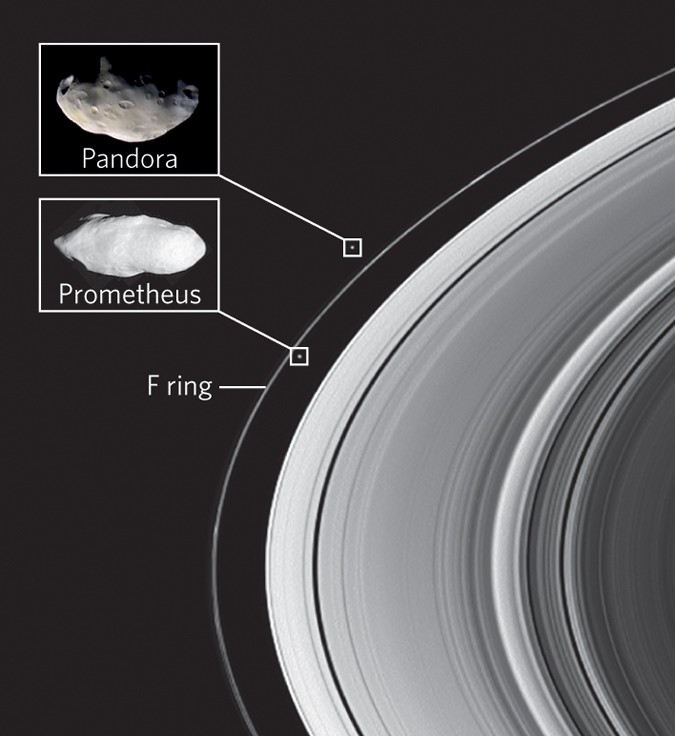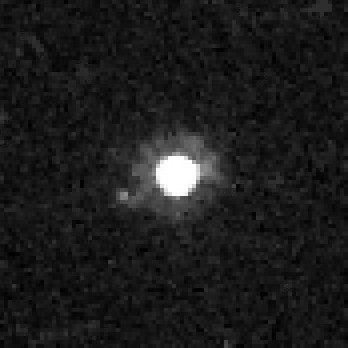"Artist impress of Quaoar rings. Credit: Paris Observatory" (ScitechDaily.com/Space Mystery: Unexpected New Ring System Discovered in Our Own Solar System)
I wrote about this topic recently. In that text, I mentioned that the solar wind and other things are weaker at the solar system's edge than they are at the inner solar system. So theoretically, planet Earth could also have a ring system because Van Allen radiation or plasma belt can trap particles in that area. But a strong solar wind or ion flow from the Sun blows that ring away.
But the size of dwarf planet Quaoar is about half the size of Pluto. That means there should not be volcanic activity inside that dwarf planet. In that case, the rings require a magnetic field. And that magnetic field requires planets that planet has a liquid mantle. Also, the moon of that dwarf planet should affect that ring system.
Shepherd moons in Saturn's rings.
The Weywot-moon can act as a shepherd moon. Shepherd moons keep the Saturn rings in their form. That kind of object can keep those rings in form. A weak gravitation field, along with a small shepherd moon can explain those rings. But can they form without a magnetic field?
The Quaoar is not a water world covered with icy shells. That requires volcanic activity or some gravitational effect must keep water liquid. Is its moon Weywot so massive that it can keep water liquid in that small world? In light water vaporizes at a lower temperature than on Earth. The Quaoar's gravitational field is not strong.
Quaoar with its moon Weywot.
That means the ice is extremely thin on that dwarf planet. So the Weywot-moon can cause friction and form an icy fog. Could some kind of low-temperature ion layer- or an extremely low-temperature fog cause situation that those particles that travel around Quaoar to form a magnetic field in its atmosphere?
If there are magnesite bites or some ions in that fog, that thing can form a magnetic field if it surrounds the iron nucleus. And in that case, the iron bites can be on the Quaoar's surface. The gravitational effect or tidal forces of Jupiter keeps at least some part of its moon liquid. But also other liquids like liquid hydrocarbon or liquid nitrogen can rise magnesite bites from the bottom of the small dwarf planets. And those bites can form a magnetic field on those objects.
But the mystery is why Quaoar seems to have a magnetic field. Is there some kind of radiation pike that impacts that small world? If some kind of pike-form electromagnetic radiation impacts that dwarf planet's nucleus, that can form some kind of electromagnetic impulse that traps those particles around that small world.
But are those yet unknown radiation pikes the thing that forms the icy geysers on the icy moon Triton? Neptune's gravitation is very strong. But is it strong enough that it can form those icy geysers?
Another thing that could form icy geysers is the radiation pike that hits the Triton surface. The radiation pike would melt icy gas on the Troton's surface and form the icy geysers.
South polar region of Triton. Active and quiescent geysers are the linear black markings. The south polar cap region transitions to cantaloupe terrain (bluish) between the end of the whitish south polar cap and the beginning of the blue. Image courtesy NASA JPL via EarthSky blog, 2019 (Volcano Hotspot/ The Nitrogen Geysers of Triton)
Triton icy geysers. The liquid that erupts from there is nitrogen. But something must disturb the balance of that icy gas that it can form the geyser.
The conclusion is that there is something that we cannot see at the edge of our solar system. There are strange disturbances in Neptune's trajectory. The question is: what causes those disturbances? Hypothetical Planet X could explain those anomalies. But mysterious Planet X cannot explain the icy geysers.
The gravitational effect from that mysterious object should affect Neptune's rings and its moons. It could also pull objects to itself. And if Triton is in those particle's route they could impact that small moon. But the dominating thing is Neptune's gravitational field. That should form a similar phenomenon also to other Neptune moons. Also, nobody saw those falling particles.
Uranus' X-ray emission
Neptune is a massive planet. And that means the effect that causes anomaly in its trajectory should be massive. And if hypothetical Planet X exists, it should collect particles from Kuiper's belt around it. Those objects should uncover on that planet.
If Planet X exists, the gravitational effect should cause anomalies to planet Uranus. The most well-known anomaly of that planet is where Uranus lies. That means Uranus' poles are turning to the Sun. The second anomaly is that there is some kind of X-ray emission in Uranus' higher atmosphere.
Uranus is lighter than Neptune, and there are no other anomalies. The only strange thing is just the planet's position. Is there something bigger than Planet X that can fall the planet Uranus? And is that anomaly some kind of energy pike or channel? In this model, some kind of energy pike impacts the planet and falls it to the position where we see it today. But why that thing is not visible in any other object in the solar system?
https://www.nasa.gov/mission_pages/chandra/images/first-x-rays-from-uranus-discovered.html
https://www.space.com/rare-ice-on-neptune-moon-triton.html
https://solarsystem.nasa.gov/planets/hypothetical-planet-x/in-depth/
https://www.universetoday.com/99111/shepherd-moon-face-off/
https://volcanohotspot.wordpress.com/2020/09/01/the-nitrogen-geysers-of-triton/
https://en.wikipedia.org/wiki/Neptune
https://en.wikipedia.org/wiki/50000_Quaoar
https://en.wikipedia.org/wiki/Uranus
https://en.wikipedia.org/wiki/Weywot
https://shorttextsofoldscholars.blogspot.com/








No comments:
Post a Comment
Note: Only a member of this blog may post a comment.